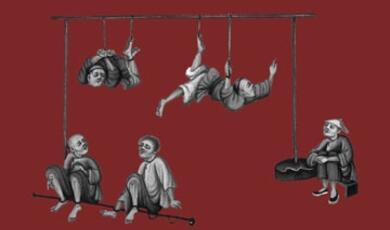Family Law: Rights and social consequences
Share
- Details
- Text
- Audio
- Downloads
- Extra Reading
This is the 2005 annual Gray's Inn Reading.
Other Gray's Inn Reading lectures can be accessed here:
2013 - 2013 Gray's Inn Reading by The Rt Hon The Lord Goldsmith QC
2012 - Privacy and Publicity in Family Law - Their Eternal Tension by The Rt Hon Sir Nicholas Wall
2011 - Beanstalk or living instrument?
by the Rt Hon the Baroness Hale of Richmond
2010 - The creation of the supreme court by Lord Hope of Craighead LLD FRSE
2009 - Sisters-in-Law by The Hon Michael Beloff QC
2008 - Terrorism: Cold War or Bad Law? by Lord Carlile of Berriew QC
2007 - Access to Justice: Keeping the doors open by Michael Napier CBE QC
2006 - The International Dimension of Judicial Review
by The Rt Hon Sir Stephen Richards
2004 - Tackling Cross border crime by Clare Montgomery QC
Download Text
FAMILY LAW: RIGHTS AND CONSEQUENCES
The Hon Mrs Justice Bracewell
Historically family law has been concerned with inheritance and property rights, And therefore validity of marriage, legitimacy and breach of promise. Novels and plays have always been popular with tales of romantic love, but for the middle classes as well as the aristocracy, marriage was usually a commercial contract and the value of a bride lay in her financial contribution.
The dispossessed poor had no relevance to family law, apart from the ethos of the Poor Law, which was to shift the burden of providing for an illegitimate child of an unidentified father onto another parish if some tenuous connection could be found.
Sermons were preached from the pulpits condemning the sins of cohabitation, but the poor often did not marry, and the courts concerned themselves with the children of the rich with expectations of inheritance. Death was ever present, and rich orphans were protected from financial adventurers by Wardship. Not until the last half of the 20th century would Wardship be engaged to protect the weakest and most vulnerable children with no expectations whatever.
Until the 19th century the patriarchal system of values which were reflected in the law meant that a married woman was in essence a slave within a free society. Her person, her property, her earnings and her children all passed to the absolute control of her husband. The husband had the right to use her sexually, beat her within reason and confine her for disobedience to his orders. The children were at the disposal of the father who could remove them, or marry them without consulting his wife. He could prevent his wife from seeing the children or even writing to them. Only personal affection and esteem between husband and wife could ameliorate the law, but if relationships broke down and turned nasty, the full force of the law could have disastrous consequences for the wife. Few women would choose to access the courts unless desperate, and yet there are records of brave and feisty ladies who did so. Even if a judicial separation was granted to the wife, the husband had the continuing right to enjoy the income of property inherited by the wife as well as her fixed capital and any earned income. Years after the separation a husband was entitled to Remove every piece of furniture, money and goods from the wife as demonstrated in the case of Calvert v Calvert, the wife being the granddaughter of Charles II and Barbara Villiers.
An even greater deterrent was the likelihood of losing all contact with her children and well into the 19th century whatever the conduct of the husband, he had absolute control of the children until the Court of Chancery and later the common law started to grant custody of small children to so called impeccable mothers.
A revealing example is the reported Turst v Turst in the early part of the 18th century. The husband an impecunious sergeant at arms to George I married Catherine Petter a young woman of some fortune. Because of the disparity in their means, an agreement was made that her estate be settled on trustees for her exclusive personal use. The marriage was a disaster in that her husband, who was a violent drunkard, had an agenda to beat his wife into submission so that she would release control to him of her fortune, he threatened to lock her in an asylum, he removed their three children from the home informing his wife falsely that the youngest had died. He kept her a prisoner locked in her bedroom. In 1733 she managed to flee but he sought her out. When he found her, he again imprisoned her, took all her possessions and beat her over a four day period with a birch stick. Still she would not yield to him. This time, her relatives issued a Writ of Habeas Corpus and she appeared black and blue before the Chief Justice. She was released and she successfully sued her husband in the London Consistory Court for judicial separation, however she never saw her children again, because the ecclesiastical court had no jurisdiction over custody. However badly the husband had behaved he had absolute power over his children.
Until the 19th century, the breakdown of marriage was the prerogative of the Ecclesiastical Courts exercising mediaeval canon law, which had been left unaltered at the Reformation, save for a reduction in the number of prohibited degrees of incest. Marriage was easy to enter into, but impossible to dissolve legally without an Act of Parliament which was permitted from the 1ih century but available only to the richest in society.
If the poor married and then separated, it was the Poor Law which highlighted the penury of the deserted wife, who was often the victim of the husband joining the Army or Navy and thereby abandoning family responsibilities. It was not until 1878 and 1886 that legislation was passed which enabled a battered or deserted wife to seek maintenance from the Magistrates Court, in the year 1900, there were 10,700 applications by wives.
Well into the 19th century, wives who were separated from their husband had no protection for their property and earnings against seizure by their husband.
A bill drafted by Lord Brougham was based on suggestions made by upper middle class women in 1854, accompanied by a petition with 25,000 signatures. Examples of injustices suffered include - a separated wife who established a thriving millinery business. The husband then seized her earnings, sold her stock, collected the debts and kept the money. Another example was a deserted wife who was abandoned penniless when the husband went to Australia with another woman. That relationship broke down and the husband returned to this country. In the meantime wife had established a successful school which the husband appropriated.
The Act of Parliament gave some protection for the property of separated wives, but it was not until 1882 that the Married Woman's Property Act secured the property of a wife. In order to have equal access to the divorce court wives had to wait until 1923.
When legal changes occurred in the 19th century they came slowly, and as a result of the developing realisation among men of power that absolute authority was no longer justified by the practicalities of family life. Feminists of the 17 th and 18th century had been widely read, but strangely they exercised little influence. It took a wellborn intelligent and well-connected woman Caroline Norton to lobby politicians and judges about her own marital problems in order to effect change. Falsely accused of adultery by her husband, he abducted their three children. Although she was acquitted of adultery her husband refused to return the children to her, and his own counsel conceded this was a ploy to barter reduced maintenance for her. The law gave her no remedy but persistent lobbying led to the 1839 Child Custody Act which empowered the Court of Chancery to transfer legal custody of children under the age of seven to the mother. Only after the age of seven could the father claim legal custody. Visitation rights were also granted to the spouse without the children, notably wives who had committed adultery, were specifically excluded and they continued to be deprived of even access to their children whereas no such bar applied to husbands.
As late as 1862 a Judge refused to grant a wife any contact to her children and observed, " it will probably have a salutary effect on the interests of public morality that it should be known that a woman, if guilty of adultery will forfeit as far as this court is concerned, all rights to the custody of or access to her children”.
It was only in 1873 that Parliament empowered the Divorce Court to grant custody to a mother of children up to the age of fourteen, even if she was guilty of adultery, and it took until 1925 for the welfare of the child to become the paramount consideration.The Second World War gave rise to massive social upheaval and disruption of relationships. There were significant consequences for family law.
Firstly, women tasted independence in the workplace on a scale never previously contemplated. Secondly, the mass evacuation of children from the cities to the country and to overseas, gave impetus to welfare consideration, and led to the development of child protection and social services run by local authorities.
Thirdly, the divorce rate soared. Whereas in 1861 there had been 141 divorces and in 1911 580, by 1947 there were 60,000. Legal Aid became available in 1949 and the trend continued, leading to the current position of 2 in 5 first marriages ending in divorce, and even more second marriages. Welfare state benefits facilitated the trend and as divorce became common so the stigma and sense of failure disappeared. The opportunity to escape from an unhappy and perhaps abusive marriage has to be balanced against the social outcomes.
It is well documented that the social consequences are not all good, particularly for women and children. Women are less likely than men to remarry. Frequently they have the responsibility of caring for the children on limited incomes and for many women the prospects are bleak. Only a tiny minority capture the headlines with massive financial settlements. The reality for most is insufficient capital and income to rehouse and maintain both parties in separate establishments. The cost to the taxpayer for consequential welfare benefits is huge, but even so, standards of living often drop. Woman who have spent some years at home are greatly disadvantaged in returning to work, and many can only take on poorly paid part time work because of their child car responsibilities. To qualify for a full pension is impossible for many. In the year 2000 only 12% of women aged 50-59 were expected to qualify for full basic state pension entitlement.
Parliament attempted to remedy the position by permitting the division of future pension rights on divorce, it has not had the desired effect. Research has shown that men make up the shortfall after divorce, whereas women with children to care for rarely earn enough to contribute to pensions after divorce. The essence of the problem is that the pension disadvantage is associated with caring responsibilities and motherhood, and women remain mothers long after divorce.
In respect of the children, unless there is a high quality of cooperation between the parents it is well established that divorce adversely affects the development, and well being of the children when compared with stable and secure parental relationships. Children need two parents. Statistically the children of divorced parents are at greater risk of failing at school, turning to crime, being unable to establish good lasting relationships and experiencing emotional and mental health problems.
These problems are often exacerbated in relationships where the parents have never married. The breakdown rate for cohabitation is significantly higher than for marriage, and serial cohabitation with different fathers for the children does not provide the stability, which children need. In many cases the mother is left to bring up the children as a single parent with no father figure. The statistics for the future lives of these children are even more worrying. Even worse are the poor outcomes associated with adolescent pregnancy and motherhood.
How well these children of single unmarried mothers turn out is invariably associated with the network of support from family and friends coupled with heroic efforts on the part of the mothers. However for many mothers their problems are increased by their own childhood experiences with difficulties transmitted from the previous generation and passed on to the next.
It is important to consider how this situation has arisen.
In my view it emanates from various factors. Parliament, for admirable reasons, removed the distinction between legitimate and illegitimate children in 1987 by the Family Law Reform Act which implemented recommendations made in 1982 and which reflected changing public opinion. Until the 1970s a mother with an illegitimate child had few options apart from adoption, and there were 20,000 in 1970 and 4000 in 1999 of whom 2200 were in Local Authority care. Unless she had support from the father or her family it was almost impossible for a mother to keep her baby. It was usual for the child to be placed for adoption at six weeks of age and history has shown that the outcome for these children has been very good and comparable with children born into a stable family unit. The tragedy of the situation was that the mother usually had no real choice, partly from the stigma associated with illegitimacy, but principally for financial reasons. The situation changed when state welfare payments and housing became available and mothers were encouraged to keep their children by social workers, and illegitimacy was no longer viewed with disdain by the public. It is difficult to assess whether anyone could have predicted the explosion of single parent families with children born out of wedlock. The state took on the role of provider with huge consequences for the taxpayers, so that now it is a matter of comment in financial newspapers that the married family is worse off tax wise than the never married family. The Child Support Agency has not been successful in enforcing payments from absent fathers, and the phrase has been coined that some single mothers are wedded to the state.
Some of the mothers are ill prepared for parenthood in that they have no good experiences to draw on from their own childhood. One of the most demanding and difficult tasks is to raise a child and yet it is assumed that instinct and maternal feeling will be enough to succeed. Belatedly the state is recognizing that training and parenting classes are of value and SureStart is helping some families. The task is immense. It is no coincidence that the children who are being expelled from school, who roam the streets in gangs undisciplined, who create fear in others and who engage in anti social and criminal behaviour are almost always the outcome of dysfunctional and inadequate parenting. If the cycle is not broken, then the prospects for the future are alarming.
Children need to be nurtured, loved unconditionally, with a structured life and taught the skills required to lead a fulfilling life. This can be achieved whether the parents are married or not. The number of marriages in the last decade has dropped by at least a quarter. It is not the divorce rate which is dropping. The reality is that fewer people are marrying. Does it matter? If it does matter, why? for those who uphold the sanctity of marriage plainly the trend is of great concern, when the latest statistics show that 42% of children are born outside marriage. For others, who have seen stigma removed by statute and by public opinion, it may not matter very much. The argument is advanced that emancipated couples do not need the legal ties of marriage and commitment can be demonstrated without the sanctity of marriage in a church, or the legal framework of a civil ceremony. Yet others will argue that in a free democratic country no one has the right to interfere with decisions on personal freedom.
All these arguments may have force, and yet for me a deeper consideration is required, wholly apart from any moral conceptions. It is well established that relationships between cohabiting couples break down even more frequently than those who marry. This has consequences for any children. There is a wealth of evidence that children are happier, more secure and are more likely to fulfil their potential if brought up in a two-parent family. The children will do just as well if the parents, who stay together, are married or not married. It is not the certificate of marriage which makes the difference, it is the long-term commitment. Whatever the outcome for the children the fact remains that fewer children of cohabiting couples will have consistency of parenting than those of married couples.
The rights and responsibilities of the couple vary according to whether there is a marriage or not. You may well comment that people choose their lifestyle and should not be burned with the legal consequences of marriage if they do not wish it. I wonder if it is that simple.
Many women as reported in the Law Reports have discovered to their horror that there is no such thing as common law marriage, and that when a relationship breaks down after many years the woman who has stayed at home and made no financial contribution will be entitled to neither capital nor maintenance for herself. Even if she has a claim for the children, which will only benefit her until the children cease education at which point she will be homeless if she has no resources of her own. Various organizations have proposed changes to the law, but although Parliament has legislated in respect of same sex couples it has steadfastly refused to consider cohabitation.
Other countries such as Australia, France and Holland have provided rights for cohabiters in terms wide enough to encompass both heterosexual couples and same sex relationships.
I think these issues raise some fundamental questions which need to be addressed. Should the law reflect what is actually happening to family life and recognize the changes? At the heart of any government's dilemma is the sensitive question whether supporting all forms of family life may weaken regard for marriage, and the very special status it brings. This is a thorny problem. We have already seen how removing the stigma of illegitimacy and giving equal rights to children born outside marriage, has seen an explosion in the numbers of such children. Is one the consequence of the other, or does the current increase in unmarried families merely reflect changes in social attitudes? Or is it connected with the Government's efforts to eradicate poverty by targeting benefits to children generally, without regard to the relationship between there parents? As one Minister has said," We would never want to advocate a family policy that made some children feel they were first class and others feel they were second class"
Changing social patterns have made it inevitable that there are many children from non marital unions who suffer the trauma of the break up of their parents relationship in the same way as the children of divorcing parents. It could be argued that their plight is worse because the law does not monitor the arrangements for those children as would be the case after divorce.
I pose the question?
If the policy of Parliament is to protect and enhance the welfare of children regardless of whether they are legitimate or not, then does it make sense to support one family rather than the other. It is controversial.
Despite the divorce rate Parliament has not revised the formation of the marriage contract which can still be entered into at sixteen with a minimum of formalities and no meaningful preparation. On the contrary, recent legislation has concentrated on where, rather than how, marriages can be celebrated, for example the licensed stately home instead of the Registrars office.
It seems that it is not marriage which is popular, but rather weddings, because people go through them time and time again against the odds.
What are the consequences for children in modern society? If our children are not well adjusted in society, if they do not become useful fulfilled citizens in adulthood, we then create problems not only for our generation but for future generations as well.
I ask the question? What is the justice for children in our country who may be brought up by an inadequate parent in a situation compounded by drugs, poor housing, inner city life, poverty and under achieving schools?
The prospects for such a child are not good and the care system does not make for successful substitute parenting in many cases. A survey of young people in prison has revealed that most have spent time in Local Authority care or played truant from school. And 60% have dropped out of full time schooling before the age
of sixteen. Many have personality difficulties, and many have been exposed to drugs and inappropriate parenting. Of those who experience the care system but who no not transgress the law, even for them the future is not bright. If you have been in care you are much more likely to leave school with no qualifications, to have teenage pregnancies, and to be homeless on the streets with an inability to sustain good relationships. The children are the victims, and need protection but how? Each year between five and seven children are killed by strangers and that has not changed much in the last thirty years. By contrast at least two children a week die at the hands of their parents or step parents. Bye and large most parents meet their children's developmental need, and moreover, at times do so under adverse social and personal circumstances. However, there are some who are ill prepared for child rearing: They may be trapped in self-destructive behaviour for example lcoholism,drug abuse, violence,and criminal activities. They may live in poverty and suffer from all-round deprivation, or they may be mentally ill, cruel and devious, neglecting, abusing, and otherwise ill-treating their children. It is an unfortunate fact that children living in such families, exposed to maltreatment may ell behave in a very troubled and troublesome manner. In those circumstances it is the responsibility of the State and various Executive agencies to step in and take action in order to safeguard the welfare of such children and to protect them from harm. Some of those children have to be removed from home on a voluntary or compulsory basis, placed in foster or some form of residential care, or accommodated with extended families.
It is a difficult balance: To remove a child unnecessarily is unjust to leave a child with a dysfunctional family may have disastrous consequences both for the child and for society.
How is the problem to be addressed?
We cannot turn the clock back, and there is no reason to suppose that divorce and cohabitation will decline. We do not want to deprive mothers of state support, nor return to the days of the stigma of illegitimacy. Experience has shown that we need to tackle the problems on two fronts, each of which will will prove very expensive. The first relates to those children who are already causing concern by their behaviour who are being given ASBOs in the criminal courts or are being dealt with for violence and street crime. It seems to me wholly inappropriate to deal with these cases solely in the criminal courts. These children and their families need help, education and training as well as punishment. Criminal courts should have powers to compel Local Authorities to intervene with care proceedings because the criteria for the making of a care or supervision order will be met in that the child is beyond parental control or is suffering or likely to suffer significant harm by reason of the parenting given to the child. Once the threshold is established then the dynamics of the family can be addressed and appropriate resources provided to remedy the problems not only of the child but of the family.
The second approach is aimed at preventing the problems arising at all.
Nursery and Primary schools are adept at identifying children who are out of control, undisciplined with an absence of social skills, and a tendency to disrupt the class and bully other children. These children and their families need skilled help at the earliest opportunity and they should be referred to appropriate agencies. These measures would be costly and at present the resources and skills required are not in place. Social Services and Child and Adolescent Mental Health Services are hard pressed to deal with the cases they already have and they lack the necessary resources to carry out preventive work. Without timely intervention however the situation can only deteriorate. Education of prospective parents has a crucial important role. Much of society seems to have forgotten, in these days of human rights, that for every right there is a corresponding duty, and that caring for a child is both a great privilege and a responsibility to ensure that the child is nurtured.
In concluding I would like to quote from the debate in Parliament over the 1857 Divorce Act. A rather prescient Member of Parliament prophesised:
"If we increase the facilities for divorce,
we will have in the course of time
an enormous number of divorces.
If once we pass this law we can never go
back, but must continue on the same
course however terrible the evils
which flow from it "
© The Hon Mrs Justice Bracewell, Gresham College, Tuesday 16 June 2005
Part of:
This event was on Thu, 16 Jun 2005
Support Gresham
Gresham College has offered an outstanding education to the public free of charge for over 400 years. Today, Gresham College plays an important role in fostering a love of learning and a greater understanding of ourselves and the world around us. Your donation will help to widen our reach and to broaden our audience, allowing more people to benefit from a high-quality education from some of the brightest minds.


 Login
Login






